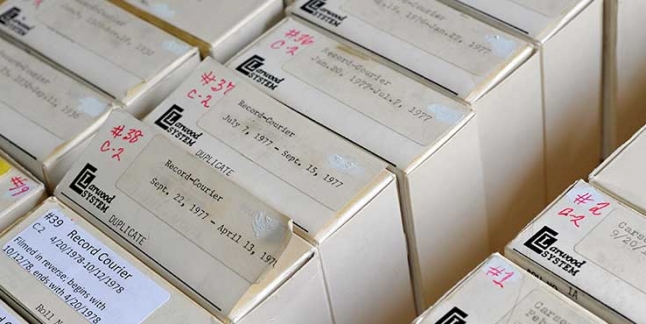Scanning Newspapers from Microfilm
Creekside Digital has processed thousands of rolls of 35mm newspaper microfilm – it’s one of the core parts of our business. All of our microfilm scanning is done in the United States on US-made NextScan equipment by factory-trained operators.
We have different levels of scanning for every institution and budget.
Standard Newspaper Scanning
For most libraries and historical societies, this is a high-quality, cost-effective option. Your newspaper microfilm is scanned on our NextScan equipment at 300dpi true optical resolution in 256-color grayscale, and output to searchable PDF files with a layer of invisible text under each page image. Typically, rolls are broken up into multipage files of ~250 pages in size (for ease of use and compatibility with older PCs). If you’ve got up to 20 rolls of newspapers, you can use our Small Order Form to view our pricing and send us your film. For collections larger than 20 rolls, we’ll create a Fulltext Index for no additional charge which allows staff and patrons to keyword-search the entire digitized archive simultaneously (all rolls) requiring only the freely available Adobe Acrobat reader software.
Premium Newspaper Scanning
For an additional charge to our Standard Newspaper Scanning, Creekside Digital will manually split individual 2-up newspaper frames into separate page images, and crop and deskew each resulting page. We will also add “sidecar” text files containing the OCR output of each page – a requirement for loading images into a searchable database or content management system such as CONTENTdm.
NDNP-Compliant Microfilm Scanning and Structural Metadata
If National Digital Newspaper Program-compliant files are required, Creekside Digital can deliver them! Each roll of microfilm is scanned in 8-bit grayscale at the maximum resolution possible (between 300dpi and 400dpi), relative to the physical dimensions of the original newspaper rather than the microfilm. This means that Creekside Digital takes the time to determine the exact reduction ratio of the source microfilm, which must be known in order to maximize the scanner’s camera’s bandwidth. Even if the film specifies a ratio, we double-check it – you’d be surprised how often those targets have the wrong number written on them! This type of attention to detail when setting up to scan a roll of microfilm is something that should always be done anyway, but unfortunately, it’s a step that most vendors cut corners on due to inexperience, lack of equipment, or just plain laziness. As with our Premium Scanning, we split all 2-up frames manually, crop to each page edge, and deskew each page.
For NDNP-compliant scanning, the following files are created for each page:
- 300-400dpi archival master TIFF (8-bit grayscale, uncompressed)
- JPEG2000 derivative
- Searchable PDF with hidden text (compatible with Acrobat 5.0, downscaled to 150dpi and using a “Medium” or 40 quality setting)
- Structural metadata XML file validated against the METS / ALTO schema
Convert ALL of your Newspapers — from Microfilm and Paper
In addition to your microfilm, Creekside Digital can also scan your hard-copy newspapers at specs which exceed NDNP and CDL guidelines. For example, we can digitize full size A2 documents (17”x24”) at up to 600dpi true optical resolution and output up to 36-bit “Deep Color” uncompressed lossless Digital Master TIFFs. You know who you are if you need this, and you also know that very few vendors can give you quality large scans at these resolutions and color depths.


